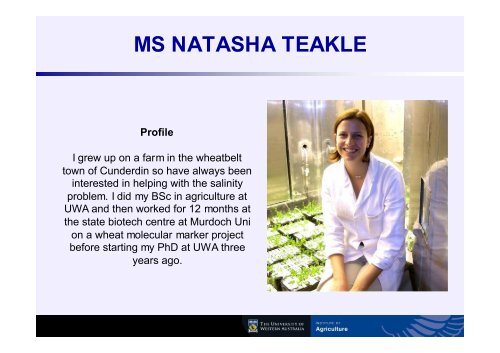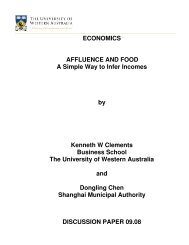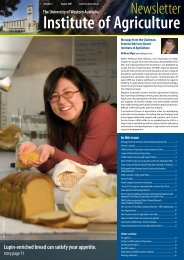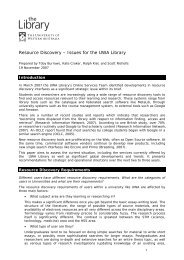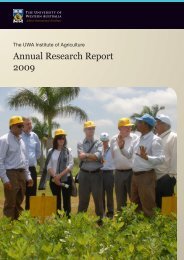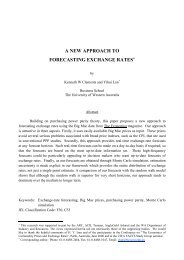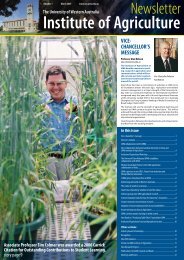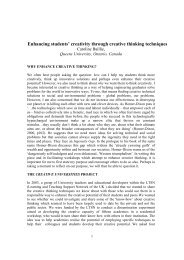Lotus tenuis
Lotus tenuis
Lotus tenuis
You also want an ePaper? Increase the reach of your titles
YUMPU automatically turns print PDFs into web optimized ePapers that Google loves.
Salinity + WaterloggingSalinity + Intermittent floodingSeasonal variationsReduced crop andpasture productionSource: R.DoyleLong-termsustainability?
Salinity + waterlogging‣ How does it affect plant growth?
Salinity + waterloggingNa + and Cl - at toxiclevels in soilCl - Cl -Cl - Cl -Na + NaNa ++Na +
Salinity + waterloggingCl - Cl -Cl -Cl - ↓O 2 Anoxic rootsNa + NaNa ++Na +
Salinity + waterloggingCl - ClCl - Cl - - Na + Na +Cl -Cl - Cl -Cl -•Na + and Cl -accumulate to toxicNa + Na + levels in shoots•Growth severelyreduced•Negative interactionfor most crop andpasture species↓O 2Na + NaNa ++Na +Barrett-Lennard 2003 Plant and Soil, 253, 35-54.
How can weprevent this?OR?How can wemake this moreproductive ANDsustainable?Source: R.Doyle
How can weprevent this?One option:PERENNIAL PASTURESHow can wemake this moreproductive ANDsustainable?Source: R.Doyle
Problem:‣ Very few species suitable for agriculture cantolerate combined salinity and waterlogging‣ And no perennial legumes!
Lucerne – intolerant of waterloggingBalansa clover dominates in Year 2 of a legume trial in SA where sitewas recently waterlogged. Lucerne (bare plot) performed well prior towaterloggingSlide courtesy of Megan Ryan
<strong>Lotus</strong> <strong>tenuis</strong> (syn. L. glaber)‣ Identified by Salinity CRC as a ‘priorityspecies”‣ Perennial pasture legume‣ Origin Mediterranean‣ Naturalised in Argentina‣ Highly palatable, tolerant to hostile soils
<strong>Lotus</strong> corniculatus‣ Most widely grown <strong>Lotus</strong> sp.‣ Closely related to <strong>Lotus</strong> <strong>tenuis</strong>‣ More productive but:• less flooding tolerant(Vignolio et al 1999)• less salt tolerant(Schachtman and Kelman 1991)
Project aims‣ Is L. <strong>tenuis</strong> more tolerant to COMBINED salinity& waterlogging?‣ What is the physiological basis for tolerance?‣ What genes might be involved?
Outline‣ Salinity & waterlogging in agriculture‣Tolerance in perennial <strong>Lotus</strong>‣ Physiology‣ Candidate genes
Tolerance to salinity andwaterlogging‣ Treatments imposed after 4weeks1. Aerated2. Stagnant agar(Wiengweera et al 1997 Annals of Botany 80:115-123)3. Saline(0-400 mM NaCl)4. Stagnant saline(200 mM NaCl)
Tolerance to salinity and waterloggingShoot DW as % of aerated non-saline control after 56 dtreatmentStagnant200 mM NaClStagnant plus200 mM NaCl<strong>Lotus</strong> <strong>tenuis</strong>L. corniculatus<strong>Lotus</strong> <strong>tenuis</strong>L. corniculatus<strong>Lotus</strong> <strong>tenuis</strong>L. corniculatus114%92%65%46%24%5%Teakle et al, 2007, Journal of Experimental Botany 58, 2169-2180.
Tolerance to salinity and waterloggingShoot DW as % of aerated non-saline control after 56 dtreatmentStagnant200 mM NaClStagnant plus200 mM NaCl<strong>Lotus</strong> <strong>tenuis</strong>L. corniculatus<strong>Lotus</strong> <strong>tenuis</strong>L. corniculatus<strong>Lotus</strong> <strong>tenuis</strong>L. corniculatus114%92%65%46%24%5%Teakle et al, 2007, Journal of Experimental Botany 58, 2169-2180.
Outline‣ Salinity & waterlogging in agriculture‣ Tolerance in perennial <strong>Lotus</strong>‣ Physiology‣ Root aeration traits‣ Ion concentrations‣ Candidate genes
Root porosityTreatment Species Root porosity (%)AeratedL. <strong>tenuis</strong>L. corniculatus17.9 (1.4)*7.5 (0.3)StagnantL. <strong>tenuis</strong>L. corniculatus34.3 (1.5)*20.5 (1.0)NaClL. <strong>tenuis</strong>L. corniculatus13.7 (1.0)*5.9 (0.9)Stagnant-plus-NaClL. <strong>tenuis</strong>L. corniculatus29.7 (0.6)21.1 (3.1)Teakle Teakle et al et 2006 al, 2007, Plant Journal and Soilof 289, Experimental 369-383. Botany 58, 2169-2180.
AerenchymaCONSTITUTIVE for <strong>Lotus</strong> <strong>tenuis</strong><strong>Lotus</strong> <strong>tenuis</strong><strong>Lotus</strong> corniculatusTeakle et al 2006 Plant and Soil 289, 369-383.
Radial Oxygen Loss600500<strong>Lotus</strong> <strong>tenuis</strong>L. corniculatusStagnantROL (nmol m 2 min -1 )40030020010000 10 20 30 40 50 60Distance from root tip (mm)Teakle et al, unpublished data
<strong>Lotus</strong> <strong>tenuis</strong> has better root aerationthan <strong>Lotus</strong> corniculatusTreatment Species Root porosity(%)AeratedL. <strong>tenuis</strong>L. corniculatus17.9 (1.4)*7.5 (0.3)StagnantL. <strong>tenuis</strong>L. corniculatus34.3 (1.5)*20.5 (1.0)<strong>Lotus</strong> <strong>tenuis</strong>Stagnant<strong>Lotus</strong> corniculatus600NaClStagnant-plus-NaClL. <strong>tenuis</strong>L. corniculatusL. <strong>tenuis</strong>L. corniculatus13.7 (1.0)*5.9 (0.9)29.7 (0.6)21.1 (3.1)ROL (nmol m 2 min -1 )500400300200<strong>Lotus</strong> <strong>tenuis</strong>L. corniculatus10000 10 20 30 40 50 60Distance from root tip (mm)
Outline‣ Salinity & waterlogging in agriculture‣ Tolerance in perennial <strong>Lotus</strong>‣ Physiology‣ Root aeration traits‣ Ion concentrations‣ Candidate genes
Shoot ion concentrations• Shoot Na + and Cl - after 56 d treatment:‣Saline: 200 mM NaCl‣Stagnant saline: 200 mM NaCl + stagnant agarConcentration (umol g -1 DW)40003500300025002000150010005000Na + Cl -L. L. glaber <strong>tenuis</strong>L. corniculatusSaline Stagnant/saline Saline Stagnant/salineTeakle et al, 2007, Journal of Experimental Botany 58, 2169-2180.
Shoot ion concentrationsWhat is contributing to high shoot Na + and Cl - ?40003500300025002000150010005000Na + Cl -L. L. glaber <strong>tenuis</strong>L. corniculatusSaline Stagnant/saline Saline Stagnant/salineTeakle et al, 2007, Journal of Experimental Botany 58, 2169-2180.
Salinity + waterloggingCl - ClCl - Cl - - Na + Na +Na + Na +Cl -Cl - Cl -Cl -Na + NaNa ++Na +•Hypothesis: Increased shootNa + and Cl - concentrationsare due to increased loadingin the xylemLow O 2Barrett-Lennard 2003 Plant and Soil, 253, 35-54.
Xylem feeding spittlebugs:Philaenus spumarius• Feed directly ontranspiration stream• Ion compositionunaffected•Successfully used tomeasure Na + exclusion inwheat**Never been measuredunder stagnant conditionsPonder et al 2002, New PhytologistWatson et al 2001, JExBotMalone et al 1999, New PhytologistMalone et al 2002, Plant Physiology
Xylem ion concentrations (mM)Na +Cl-86420403020100200 mM NaCl, aerated 200 mM NaCl, stagnant*<strong>Lotus</strong> L. <strong>tenuis</strong> glaber<strong>Lotus</strong> corniculatus* * *1 2 3 4403020100**1 2 3 4** ****Teakle et al, 2007, Journal of Experimental Botany 58, 2169-2180.Weeks of treatment
Xylem ion concentrations (mM)Na +Cl-86420403020100200 mM NaCl, aerated 200 mM NaCl, stagnant*<strong>Lotus</strong> L. <strong>tenuis</strong> glaber<strong>Lotus</strong> corniculatus* * *1 2 3 4403020100**1 2 3 4** ****Teakle et al, 2007, Journal of Experimental Botany 58, 2169-2180.Weeks of treatment
Xylem ion concentrations (mM)Na +Cl-86420403020100200 mM NaCl, aerated 200 mM NaCl, stagnantHypothesis accepted: ShootNa + and Cl - correlated with40<strong>Lotus</strong> L. <strong>tenuis</strong> glaberxylem Na + and Cl -<strong>Lotus</strong> corniculatus** * *30201001 2 3 41 2 3 4** ******Teakle et al, 2007, Journal of Experimental Botany 58, 2169-2180.Weeks of treatment
Root transport of Na + and Cl -‣ Influx into roots‣ Control of xylem loading‣ Accumulation in root vacuoles‣ Efflux from roots
Root/Shoot partitioningTreatmentSpeciesNet rate of Na +transport toshoot (µmol g -1root DW d -1 )Total plant Na +(µmol)Root Na +content as %of total plantNa +200 mM NaCl<strong>Lotus</strong> <strong>tenuis</strong>L. corniculatus345 + 42 a483 + 25 ab755 + 48 a1230 + 280 a59 + 3.4 a57 + 2.0 aStagnant plus 200mM NaCl<strong>Lotus</strong> <strong>tenuis</strong>L. corniculatus607 + 17 b786 + 40 c832 + 72 a903 + 153 a55 + 2.3 a39 + 1.7 bL. <strong>tenuis</strong> root Na + concentration 17% higher than L. corniculatus for stagnant +salineTeakle et al unpublished data
Root transport of Na + and Cl -‣ Influx into roots‣ Control of xylem loading‣ Accumulation in root vacuoles‣ Efflux from roots‣ Many genes involved – but which might be moreimportant for combined salinity and waterloggingtolerance?
Outline‣ Salinity & waterlogging in agriculture‣ Tolerance in perennial <strong>Lotus</strong>‣ Physiology‣ Candidate genes
Hypothesis:Better root aeration = lower xylem Na+ and Cl-Cl - Na +Cl Cl - -ClCl - - Na +Cl - NaCl -Na ++ Cl - Higher NaNa +O Na + +2Na +
Cl - ↓O 2Less O 2Salinity & WaterloggingReduced root O 2= less ATPH + -ATPase activity impairedDriving force for H + gradientacross membranes affectedCl - Cl -Cl -Na + Na +Na +Na +Hypothesis: Ion transport mechanisms will be affected that relyon a H + gradient
Na+ accumulation in root vacuoles?TreatmentSpeciesRoot Na +content as %of total plantNa +<strong>Lotus</strong> <strong>tenuis</strong>:200 mM NaClStagnant plus 200mM NaCl<strong>Lotus</strong> <strong>tenuis</strong>L. corniculatus<strong>Lotus</strong> <strong>tenuis</strong>L. corniculatus59 + 3.4 a57 + 2.0 a55 + 2.3 a39 + 1.7 bNa + accumulates inroots, preventing loadingin the xylem and hencelower shoot Na + ???L. <strong>tenuis</strong> root Na + concentration 17% higher than L. corniculatus for stagnant +salineTeakle et al unpublished data
Possible candidate gene: NHXNHX = Na+/H+ antiportervacuoletonoplastNa + NHXH +Plasmamembrane‣ Localised to the tonoplast‣ Found in many plant species to improve salt tolerance (e.g. wheat Xue et al,2004)
Cloning of a NHX1-like gene in <strong>Lotus</strong> <strong>tenuis</strong>AtNHX2 (71%)AtNHX1 (83%)LtNHX1AtNHX3AtNHX4AtNHX6AtNHX5Thellungiella halophiliaArabidopsis thalianaAtriplex dimorphostegiaSuaeda maritimaTrifolium repens<strong>Lotus</strong> <strong>tenuis</strong>Glycine maxVacuoleC-terminus42 5198 110167 217271274 324 3444381 2 3 4 5 6 7 8 9 10 11tonoplast2271 78130 147237254291304364 418N-terminusCytoplasmTeakle et al unpublished data
Functional characterisation of LtNHX1 in yeast• AXT3 (no Na + transporters) transformed with <strong>Lotus</strong> <strong>tenuis</strong> NHX•<strong>Lotus</strong> <strong>tenuis</strong> NHX-like gene improves salt tolerance of yeast0 mM NaCl 75 mM NaCl 100 mM NaCl10 -1 10 -2 10 -3 10 -1 10 -2 10 -3 10 -1 10 -2 10 -3AXT3 x LtNHX1AXT3Wild type
Expression of NHX1 in rootsReal-time qPCRRelative expression (arbitrary units)321<strong>Lotus</strong> <strong>tenuis</strong><strong>Lotus</strong> corniculatus*150 bp170 bpControl Saline Stagnant+SalineLt Lc Lt Lc Lt LcLtNHX1LtTUB1• Transcript levels of NHX decrease forL. corniculatus for stagnant+saline0Control Saline Stagnant+SalineTeakle et al unpublished data
Summary<strong>Lotus</strong> <strong>tenuis</strong> is relatively more tolerant tocombined salinity and waterloggingTolerance to salinity +waterlogging
Summary<strong>Lotus</strong> <strong>tenuis</strong> has higher root porosity due toaerenchyma and a partial barrier to ROLIncreased rootaerationTolerance to salinity + waterlogging
Summary<strong>Lotus</strong> <strong>tenuis</strong> restricts xylem loading of Na +and Cl - to the shootIncreased rootaerationLower shootNa + and Cl -Tolerance to salinity + waterlogging
SummaryExpression of NHX1 reduced for L. corniculatus but isnot affected by stagnant + saline treatment for L. <strong>tenuis</strong>Increased rootaerationLower shootNa + and Cl -Tolerance to salinity + waterloggingMolecular basis???
SummaryIncreased rootaerationLower shootNa + and Cl -Tolerance to salinity + waterloggingBreeding targets: genes for Na + and Cl -transporters that are affected by O 2 deficiencies
Acknowledgements‣ Supervisors: A/Prof Tim Colmer and Dr Daniel Real‣ Collaborators:Dr Anna Amtmann (Glasgow Uni)Prof Tim Flowers (Sussex Uni)‣ Funding: GRDC, AW Howard, Salinity/FFI CRC


